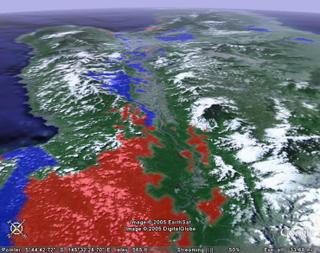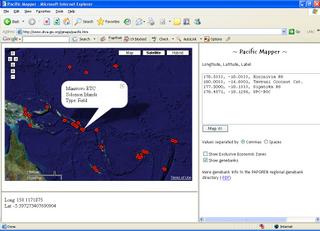

A blog maintained by Tevita Kete, PGR Officer
Secretariat of the Pacific Community (SPC), Suva, Fiji Islands
This weblog documents the activities of Pacific Agricultural Genetic Resources Network (PAPGREN), along with other information on plant genetic resources (PGR) in the Pacific.
The myriad varieties found within cultivated plants are fundamental to the present and future productivity of agriculture. PAPGREN, which is coordinated by the Land Resources Division of the Secretariat of the Pacific Community (SPC), helps Pacific countries and territories to conserve their crop genetic diversity sustainably, with technical assistance from the Bioversity International (BI) and support from NZAID and ACIAR.
SPC also hosts the Centre of Pacific Crops and Trees (CEPaCT). The CEPaCT maintains regional in vitro collections of crops important to the Pacific and carries out research on tissue culture technology. The CEPaCT Adviser is Dr Mary Taylor (MaryT@spc.int), the CEPaCT Curator is Ms Valerie Tuia (ValerieT@spc.int).

PAPGREN coordination and support

Click on the thumbnail to see a map of the locations of Pacific genebanks. Click here to download a regional directory of genebanks in the Pacific, including information on their location, contact details and holdings.
PAPGREN partners
Mr William Wigmore
Director of Research
Ministry of Agriculture
Department of Resources & Development
P.O. Box 96
Rarotonga
Cook Islands
Tel: (682) 28711-29720
Fax: (682) 21881
Email: cimoa@oyster.net.ck
Mr Adelino S. Lorens
Chief
Agriculture Pohnpei
Office of Economic Affairs
P.O. Box 1028
Kolonia
Pohnpei 96941
Federated States of Micronesia
Tel: (691) 3202400
Fax: (691) 3202127
Email: pniagriculture@mail.fm
Dr Lois Englberger
Island Food Community of Pohnpei
Research Advisor
P.O. Box 2299
Kolonia
Pohnpei 96941
Federated States of Micronesia
Email: nutrition@mail.fm
Mr Apisai Ucuboi
Director of Research
Ministry of Agriculture, Fisheries & Forest
Koronivia Research Station
P.O. Box 77
Nausori
Fiji Islands
Tel: (679) 3477044
Fax: (679) 3477546-400262
Email: apisainu@yahoo.com
Dr Maurice Wong
Service du Developpement Rural
B.P. 100
Papeete
Tahiti 98713
French Polynesia
Tel: (689) 42 81 44
Fax: (689) 42 08 31
Email: maurice.wong@rural.gov.pf
Mr Tianeti Beenna Ioane
Head, Research Section
Division of Agriculture
Ministry of Environment, Lands and Agricultural Development
P.O. Box 267
Tarawa
Kiribati
Tel: (686) 28096-28108-28080
Fax: (686) 28121
Email : agriculture@tskl.net.ki; Beenna_ti@yahoo.com
Mr Frederick Muller
Secretary
Ministry of Resources & Development
P.O. Box 1727
Majuro 96960
Marshall Islands
Tel: (692) 6253206
Fax: (692) 6257471
Email: rndsec@ntamar.net
Mr Herman Francisco
Director
Bureau of Agriculture
Ministry of Resources & Development
P.O. Box 460
Koror 96940
Palau
Tel: (680) 4881517
Fax: (680) 4881725
Email: bnrd@pnccwg.palaunet.com
Ms Rosa Kambuou
Principal Scientist PGR
NARI Dry Lowlands Programme
Laloki Agricultural Research Station
P.O. Box 1828
Boroko
National Capital District
Papua New Guinea
Tel: (675) 3235511
Fax: (675) 3234733
Email: kambuou@global.net.pg
Ms Laisene Samuelu
Principal Crop Development Officer
Crops Division
Ministry of Agriculture, Forests, Fisheries & Meteorology
P.O. Box 1874
Apia
Samoa
Tel: (685) 23416-20605
Fax: (685) 20607-23996
Email: lsamuelu@lesamoa.net
Mr Jimi Saelea
Director of Research
Department of Agriculture and Livestock
P.O. Box G13
Honiara
Guadalcanal
Solomon Islands
Tel: (677) 27987
Mr Tony Jansen
Planting Materials Network
Kastom Gaden Association
Burns Creek, Honiara
P.O. Box 742
Honiara
Solomon Islands
Tel: (677) 39551
Email: kastomgaden@solomon.com.sb
Mr Finao Pole
Head of Research
Ministry of Agriculture & Forests
P.O. Box 14
Nuku'alofa
Tonga
Tel: (676) 23038
Fax: (676) 24271
Email: thaangana@hotmail.com
Mr Frazer Bule Lehi
Head of Research
Department of Agriculture & Rural Development
Private Mail Bag 040
Port Vila
Vanuatu
Tel: (678) 22525
Fax: (678) 25265
Email: flehi@hotmail.com
Other CROP agencies
Forum Secretariat
University of the South Pacific
SPREP
Pacific biodiversity
Biodiversity hotspots
Breadfruit Institute
Hawaiian native plants
Intellectual property rights
Nature Conservancy
PBIF
PestNet
SIDS
WWF South Pacific Program
Other Pacific organizations
Foundation of the Peoples of the South Pacific
Micronesian Seminar
Te Puna web directory
Pacific news
Cafe Pacific
CocoNET Wireless
Island Directory
Pacific Islands News
Pacific Islands Report
Pacific Islands Travel
Pacific Time
South Pacific travel
Time Pacific
Interested in GIS?
DIVA-GIS
Thursday, September 08, 2005
More Pacific mapping
Google Earth (http://earth.google.com/) has a function for perspective views which can be quite useful. In the attached, I’ve draped an image of areas where taro (red) or banana (blue) is the dominant staple from the (PNG Farming Systems Database) over a view of northern PNG looking SE from a height of about 36 miles.

Solomon Islands agriculture
The Solomon Islands government is pinning its hopes on a new agriculture strategy to help drive the economy back into the black. A five-year plan, developed by stakeholders in the newly formed Agriculture Council, targets the rural sector as a major player in its so-called 'Rural Livelihood Plan'. The 'Agriculture Sector Strategies Plan 2005 and Beyond' aims to help individual farmers achieve product quality standards, productivity and management levels.
Speakers: Edward Kingmele, Permanent Secretary, Solomon Islands Department of Agriculture and Livestock
http://www.abc.net.au/ra/pacbeat/stories/s1455934.htm
Resources on food processing
Thanks to Malcolm Hazelman of FAO for pointing these out:
- An FAO report by Lynda D. Wickham on Small Scale Processing of Starchy Staples in CARICOM Countries: bananas and plantain (Musa spp.), breadfruit and breadnut (Artocarpus altilis and A. camansi), yams (Dioscorea spp.), cassava (Manihot esculenta Crantz), sweet potato (Ipomoea batatas) and the edible aroids, dasheen (Colocasia esculenta var. esculenta), eddoe (Colocasia esculenta var. antiquorum) and tannia (Xanthosoma sagittifolium)
- A feature article from the journal Mechanical Engineering: How do you design food-processing equipment if you know little of the culture in which it will be used?
Wednesday, September 07, 2005
New Book on Hawaiian Breadfruit
Hawaiian Breadfruit: Ethnobotany, Nutrition, and Human Ecology
by Brien A. Meilleur, Richard R. Jones, C. Alan Titchenal, and Alvin S. Huang
Here's the blurb from the publishers, the College of Tropical Agriculture and Human Resources at the University of Hawaii at Manoa
Breadfruit, called ‘ulu in Hawaiian, was one of the plants Polynesians brought in their sailing canoes when they discovered the Hawaiian Islands. It is a staple food throughout the Pacific, and in ancient Hawai‘i it was a crop of much greater nutritional, cultural, and political significance than its presentday status here suggests. The authors of this book assembled historical references to ‘ulu and did nutrient analyses to develop a picture of the tree’s former importance. Through its manifold uses, its widespread cultivation, and its nutritional similarity to the other Hawaiian staple, kalo (taro), Hawaiian breadfruit is revealed to have had a profound role in the Hawaiian culture and the human ecology of the archipelago. This brief study of ‘ulu will reward those interested in Hawaiiana with a new perspective on a familiar tree of Hawaiian landscapes, a tree which—according to the authors—deserves much greater appreciation and use.
Tuesday, September 06, 2005
Mapping the Pacific
It is often useful to be able to quickly visualize the location of a particular site or sites on a background of a satellite image. Google Map not only provides free satellite imagery for the whole world on the web, but also software for doing simple mapping with that imagery on your own website. A colleague of mine, Dr Robert Hijmans of the University of California, Berkeley, has kindly set up a webpage at http://www.diva-gis.org/gmaps/pacific.htm which allows you to rapidly plot points for which you have latitude and longitude on a Google Map satellite image base map. He has included an option for also overlaying the EEZ of PICTs. I hope you find it useful. All feedback welcome. You can do more sophisticated spatial analysis for biological and natural resources management with the DIVA software available on the same site.

Thursday, September 01, 2005
Breadfruit processing
From Jim Currie in FSM.
I fully support the efforts described by Adelino Lorens concerning processing breadfruit whether for sale or home use. When Richard Byers was here last year, he demonstrated that local breadfruit could be ground, extruded and when dropped in hot oil it puffed up just like 'cheese balls'. I personally am addicted to 'Ulu' (breadfruit) chips from Samoa. I think these should completely replace the junkfood we import from elsewhere. If the cost is higher, so what. Junk food is a non-essential and if people want it, they can save toward it or make it themselves. If they decide to not buy or make, maybe that is even better since they avoid the empty calories that now show up in the obesity statistics. I'd even support a ban on imported junk food.
From our possition COM/FSM, we are planning a two-pronged approach to the breadfruit issue and other staple crops as well.
In the first and easiest case, we (Engly Ioanis, Marcellino Martins, and I are planning a research/ demonstration project in three of the states of FSM to demonstrate the preservation and use of Breadfruit as the basis for a balanced swine feed diet. There are tons of breadfruit that go to waste each year while we import pig feed that is primarily energy feed based. Even if we use more breadfruit for human consumption, there will always be damaged, diseased and excess available to be preserved as feed for pigs.
Secondly, we will be hiring/acquiring a person - possibly through volunteer agencies or technical support agencies - to work full-time in Food Processing, Packaging and Marketing. One of the challenges for this person will be to develop a processing system to transform staple products to a readily useable product at a reasonable price. Possibly the extruding idea could be carried out to form a pelleted product in a sealed pack that could be easily boiled or micro-waved comparable to 'minute-rice' (that takes 10 minutes anyway). I fully expect that some of these have been developed in the region and I solicit any guidance in this topic in which I am less specialized.
Another idea that came to mind while discussing with Adelino was the promotion of breadfruit this year at the World Food Day activities and to local restaurants. I have seen some local staples used in restaurants but I think we might be able to stimulate more interest. In Sapian, we used to hold a tilapia cook-off to promote consumption of this farm-raised fish. One part of the competition was for commercial chefs. We could do something similar here by invoiting the 15 or so Pohnpei restaurants to compete for prize and distinction by developing and displaying a recipe based on or including breadfruit. Breadfruit could be suplied free of charge to the restaurant through the Agriculture Division and judging would take place in public at the
World Food Day celebrations.
* Comments:
Archive
RSS Feed
Alternative feed
Contact Tevita
Something new:
Agrobiodiversity Weblog: For discussions of conservation and sustainable use of the genetic resources of crops, livestock and their wild relatives.
